A Place to Call Home
Chipping and Dipping for Davidsonville Wildlife Sanctuary
story and photos by Kat Burke
“There’s no place like home,” said Dorothy as she closed her eyes and clicked her heels at the end of The Wizard of Oz.
Her affirmation led her safely home, a journey that proves more difficult for animals who’ve gone wandering. Fewer than 17 percent of lost animals entering a shelter are ever reunited with their families, according to the American Humane Association.
This week, you can raise that dismal percentage and, in the process, help create a more lasting home for local wildlife. Get your dog, cat or whatever microchipped at Whole Foods Market’s annual Chip and Dip Day and you’ll help lead your pet home if ever lost. You’ll save enough money — the price is discounted 50 percent from the usual cost — to buy your pet a dip to go with the chip.
You’ll also add home comforts to Davidsonville Wildlife Sanctuary, a place many less-domestic local creatures already call home.
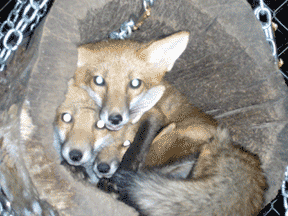
A Modern Day Ark
Abandoned animals of many species survive and thrive together in this sanctuary, nestled between the traffic of Riva and Beards Point roads. Sandra Carr, a licensed master rehabilitator, created the refuge for abandoned and injured wildlife from her family’s large property in Davidsonville. For four decades, the Carr family, along with several volunteers, has provided homes for hundreds of animals — from alpacas to peacocks — that have no other refuge. Touring the grounds of the farm, you meet a veritable Who’s Who of wildlife.
As Carr walks past the small pond housing geese and heron, she opens a large pen to pet Forrest, an emu. The friendly animal is still too small to stay in the area with the full-grown emus, so he makes his home with two recovering pot-bellied pigs and a goat named Icepick, whose long beard and single large horn give him the air of an old and weathered wise man.
“Anything Forrest thinks he can pick off you, he’ll try to get,” Carr warns as Forrest follows her, pecking lightly at her pants. “I lost an earring to him once.”
Forrest came to Davidsonville from a woman whose grandson found him in the Pennysaver. After learning how large the creatures can grow, the family gave him up. The spirited emu has no esteem issues from the abandonment. He has found his home and runs circles around his lethargic pen-mate, Icepick.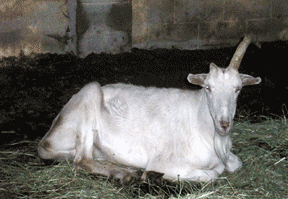
The arthritic goat has gotten used to the lively Forrest and, rising creakily, barely glances at him. Icepick was abused before his rescue. His front legs will never heal from the abuse he suffered. But the large black calluses on his knee joint, which serves as a makeshift foot, don’t stop him from following Carr back to the entrance, looking for a snack. Icepick is only one of the several animals who, according to Carr, have no place else to go.
“I hate putting a we’re full message on the machine,” a frustrated Carr says of the current message for incoming callers. “But there are strict rules to how many I can take, and I am at the max.”
Behind Icepick’s home, sheds house five pot-bellied pigs. The animals are typically adopted when they’re cute little piglets by people who don’t suspect that they’ll grow up to 200 pounds.
“It’s really hard for them when they come here because they’ve never seen another pig before,” Carr says of the orphans who’ve outgrown their adoptive home. She welcomes them with open arms, socializing them and helping them feel comfortable in their new home.
The goal is to find someone to adopt the foundlings or to set them free. That is not always possible, as was the case with a pot-bellied pig who was friendly — until adopted.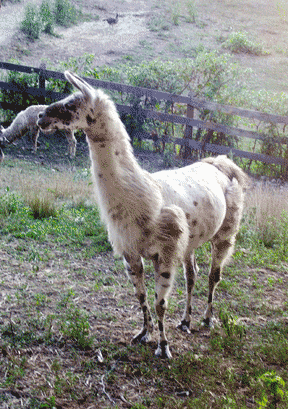
“Once the guy took him he started acting obnoxious, biting and being nasty,” Carr explains. Only after the animal was returned did its behavior become normal again. “They’re smart,” she notes. “He knew when he was home.”
Davidsonville provides this sense of home for forgotten animals of a larger sort as well. Even farther off the main road is a large pasture that backs to the woods.
A spotted llama named Freckles wanders from the pasture, past Carr and into a run-in shed as the bright sun finds its place behind the trees. “When the sun goes down, so does everything else,” Carr says as several larger animals head for their beds.
On the Way Home
As the name suggests, Davidsonville Wildlife Sanctuary also houses animals whose permanent home will be the wild. Many tenants are only temporary guests until they are large or healthy enough to find a more natural habitat.
At the moment, these babies come in threes. Separate pens house three baby raccoons, three baby foxes and three baby deer.
“Ah, you guys are bums,” Carr jokes with the raccoons as she cleans off the wood shavings that fell from their raised pen. The creatures, snuggled together, barely look up from their nap. The raccoons are all healthy and growing. Soon, Carr will drive them to one of the larger release cages in the state so they can be slowly and safely readjusted to the wild.
The three baby foxes live just a few pens over from the sleepy raccoons. All three jump into a hollowed log as Carr approaches. They are like most animals, friendly with her because they know she cares for them. But they know better than to trust strangers. That’s essential to their survival after they are released.
The small deer live in the largest house. Carr pulls out five bottles she packed, but the three deer inside the shed already had their dinner. These bottles are for the in-betweens, deer that have been released into the woods that surround the sanctuary.
“C’mon!” She bellows out over the pasture and into the woods. “C’mon! Who wants a bottle?”
Minutes later, a small deer appears at the tree line. He is a little apprehensive until she yells once more. “C’mon!” Then he flies down the large hill, past the geese that are now grazing in the dry grass, over the fence that holds the cows and the llamas, and straight to the bottle in Carr’s outstretched hand.
The deer doesn’t eat too much, but Carr says that’s a good sign.
“The older deer show the young ones what to eat and how to find it,” she explains. “If they don’t want the bottle, it means they’re getting food on their own.”
Grown deer emerge from the woods to graze and keep an eye on the young, as though the babies are theirs. Carr smiles as she talks about this cycle of life. The more deer she can release into the wild, either in Davidsonville or at other release sites in the surrounding areas, the more room the sanctuary has for injured or abandoned animals in need of a temporary safe place to call home.
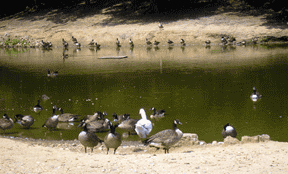
Those in Need
A small shed on the property that Carr dubs the clinic holds animals that need special attention. Here the small animals cling to life and hope. An injured pigeon occupies the center cage.
“It’s man’s fault,” Carr explains. “They genetically breed them to have that hood, she says of the clump of feathers surrounding the bird’s head. “He couldn’t even see the tree beside him.” The pigeon, probably loose from a trainer, would have been put down if not for the sanctuary.
Behind the bird, a wild bunny hit by a car lies quietly. He can’t straighten his body and has signs of head trauma. But he has no broken bones and he can still eat and drink, reason enough for Carr to keep providing care and to hope that he will heal.
Across the street, behind the stables, lives one of the many reasons Carr holds onto hope. Frosty the burro was kicked out at birth by his mother. Injured and covered in frost — hence the name — he was scooped up by Carr’s son-in-law. Unable to walk without braces or eat without a bottle, Frosty traveled the long road of recovery and grew into a healthy and happy member of the family.
In front of the house and in full view of the road, the waterfowl make their home on a small pond. “It’s a big project,” Carr says of the improvements that would make the pond a healthier habitat for the birds. The daunting job, which would include dredging and adding much needed landscaping and foliage, is her top priority. She worries that without the improvements, the injured heron and geese will soon have no place to go. “A lot of waterfowl depend on that pond,” she says.
For that project and others, the sanctuary depends on donations, volunteers and grants simply to maintain the property as it is. Much needed improvements and repairs take a back seat to food for the animals — $1,200 each month — medicine and vet bills.
Lend a Helping Hand
As one of the beneficiaries of the third annual Chip and Dip Day at Whole Foods Market, the sanctuary could dredge its pond sooner rather than later. Past events have raised several thousand dollars for organizations like the Calvert Animal Welfare League, Greyhound Animal Rescue and Tails of Hope. This year’s second recipient is the golden retriever rescue group GRREAT.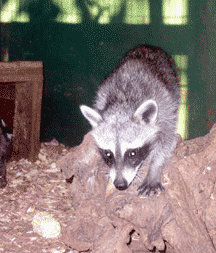
On Chip and Dip Day, the chips are brought by vets who donate their time and implant the micro-chips for $25, about half the usual cost. Microchipping is painless for the animals and more reliable than a tag or a collar if your pet ever gets lost.
The dip comes courtesy of volunteers, who — for only $10 — dip your pup or kitty into a bath, so you can leave with a squeaky-clean pet who will never be lost for long.
The title activities are only part of the fun. Animal lovers can enter a raffle, learn about other local animal rescue groups and purchase paw-print paintings.
For four-legged visitors, Paws Pet Boutique owner Michelle Kownacki organizes games, with prizes for the winners of The Waggiest Tail, The Sit/Stay and The 9-Step Dog Day Contest.
The first 200 dogs to arrive also enjoy gourmet treats donated by Paws.
“It is so important to get involved and make a difference in our community,” Kownacki says.
Whole Foods Market seconds that notion by donating five percent of the net sales between 7am and 10pm during Chip and Dip day to Davidsonville Wildlife Sanctuary.
You can help too, by chipping, dipping and making donations of goods or money. Blankets, towels, cages and aquariums or materials like plywood and lumber for fences and sheds are not ruby slippers. But they help make Davidsonville Wildlife Sanctuary someplace like home.
Kat Burke is a high school English teacher and a novelist who writes from Annapolis. This is her first feature for Bay Weekly.
|
